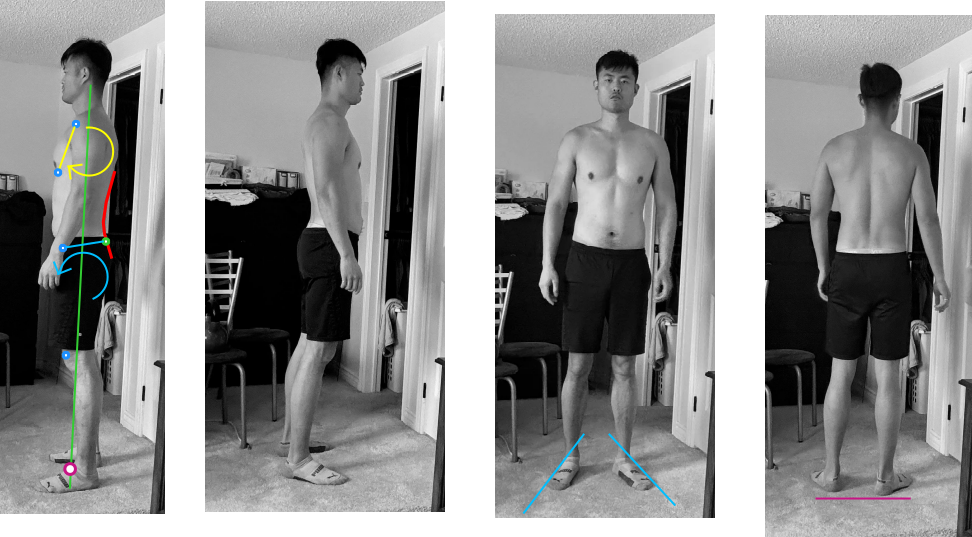Original request: https://www.reddit.com/r/PostureAssesments/comments/1h8brra/pretty_sure_i_have_apt/

Common postural patterns displayed.
Let's discuss the drawings first:
Green line is the referential plumb line. It's set in the purple spot (talus bone), where the mass of the whole mechanism gets distributed into the arch of the foot. In your case, the line isn't vertical (due to camera lens position). I used the door architrave to adjust for the necessary correction.
There are few bony landmarks we use to systematically judge the positions of the bones (parts of the mechanism) in relation to each other and in relation to the green reference line).
Blue spots are (bottom to top): Front of the medial epicondyle (knee spot), Anterior Superior Iliac spine (ASIS, or Iliac spot), bottom sternum and finally top sternum. The green spot is the top of your sacrum.
Ideally, we would want all of the blue spots (not the green one) to be on the green line. Currently, they are not.
The knee spot is too far forward as the knee (and ankle) are not in full extension.
Next up is your pelvis. Consider it's position: The ASIS spot is too far forward and down, and the sacrum spot (green) is too high up. That means, you have a rotation in your pelvis - APT as you correctly stated. The blue line at your waist is your "belt" line (where you would normally wear a belt. The slope forwards at the front is clearly visible (rotation of pelvis indicated by blue arrow). Ideally, we would want that blue line to be horizontal.
Next big part of your mechanism is your ribcage. Here too is a rotation, except this time the opposite to the pelvis. Again, easily visible by tracking the position of your sternum in space (yellow line). Your sternum bone is the front of your ribcage. The bottom sternum is pushed forwards and the top of the sternum is pulled backwards. The ribcage rotation is indicated by the yellow arrow.
The red curve at your lowerback is your spine. It attaches to the pelvis (at the bottom) and to the ribcage (at the top). When the two massive parts of your mechanism (pelvis and ribcage) rotate in opposing directions, it creates forces that are "bending" or arching the spine as displayed.
Ideally, we would want the red curve to be absolutely flat. Remember, the lumbar vertebrae bodies are wedge shaped, so even if the spineous processes are flat (the red curve), the bodies are still maintaining their curve, which isn't visible on the outside. At the moment, the curve is too aggravated.
This red curve is what we call "shortening of your torso" and it's the biggest issue you have. From that, other issues are stemming out, such as your functional scoliosis (left / right imbalance).
You can see the scoliosis through out the mechanism as left / right imbalances. Ideally, we would be perfectly symmetrical (on the outside).
It starts with the placement of your feet - left foot is habitually placed ahead of the right. That brings the left knee ahead as well, and in turn drops pelvis down laterally on the left (easily visible by your belt leaning to the left). Because of this shift of mass at the lower body, you must compensate for that to maintain equilibrium and you do that by retracting your right arm further back in relation to your torso.